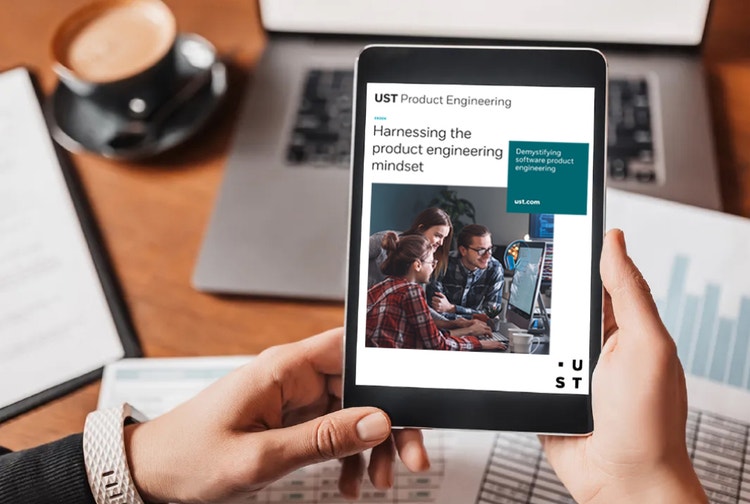

Insights
How to accelerate time to value in digital product engineering
UST Product Engineering
TTV is best understood as a metric for friction: the shorter the time to value, the less friction a user experiences from a digital product. Receive your free whitepaper and elevate your decision making.
UST Product Engineering
Related content
Digital products are essential to modern business operations. Apps, websites, and software (including SaaS) help companies be more efficient, insightful, and profitable. Many players are in the space, adding to the diversity in product quality, efficacy, and usability. In the dynamic world of digital product innovation, the ability to quickly turn ideas into value-generating products is a necessity. This concept, widely known as Time To Value (TTV), is undoubtedly one of the most important goals for any team. This guarantees a better product and a higher return on investment for product users across all industry sectors ranging from Fintech and retail to healthcare and more.
What is time to value?
TTV is best understood as a metric for friction: the shorter the time to value, the less friction a user experiences from a digital product. It represents the period from the inception of a product idea to its launch when it starts generating value. Reducing TTV is an essential strategy for businesses looking to stay ahead of the competition. While there are several key components to good digital product engineering and transformation — such as capabilities, integration, and speed — TTV is an overarching metric for all of them achieved by delivering a superior user experience.
DIVIDER
Understanding digital product engineering
Digital product engineering is designing, developing, and delivering all the major aspects of a digital toolkit, from software, apps and anything else a user might need. Often conflated with software engineering, digital product engineering has a larger scope, considering UX and business needs.
The digital products businesses use help them operate with more information, more nimbly, and reach a wider audience more deeply. These tools help automate and streamline business functions, which means they also serve businesses as investments. It is, therefore, common to see TTV compared to return on investment (ROI). While there are similarities, TTV has more nuance than is conveyed by that comparison.
DIVIDER
The importance of time to value
Business moves fast, and there is pressure for results in every industry. While developers might be experts in navigating digital products, it is important in the design phase to remember that most users will not be. For example, a common type of SaaS like Customer Relationship Management (CRM) software. CRM A might be engineered to offer users twice as many capabilities as CRM B. Still, if CRM A takes twice as long for users to become familiar with – perhaps because of confusing UX design or slow integrations – users will opt out of A for CRM B. A digital product that is less complex but offers value to its users more quickly has a shorter TTV.
A tool like a CRM is certainly being used to generate sales, which directly correlates TTV with ROI. However, in a scenario with two photo editing applications, the applications may be commercial but might not. Still, users who experience frustration in one form or another with a certain product are likely to try another. This is where TTV and ROI are not necessarily analogous.
DIVIDER
Strategies to accelerate time to value in digital product engineering
One of the most successful strategies for shortening a product's TTV is implementing an agile approach to development. An agile approach segments product development into "sprints," taking time to reflect and refine the product at intervals between sprints.
Staying agile allows all the stakeholders – engineers, customers, major shareholders, investors, the sales team, and others – to give feedback during development. Real-time needs, therefore, steer the direction of engineering; this is much more efficient than making major changes further along in development. This consequently also helps shorten a product's time to market, as it safeguards against needing to extend launch dates for such arduous revisions.
An agile approach – in tandem with breaking down the work into sprints – emphasizes building diverse, cross-capable teams that can home in on specific targets. By bringing multiple perspectives and sets of expertise to engineering one product feedback comes from multiple angles after each sprint, bringing more sophisticated insight and troubleshooting.
The best way to utilize human resources to accelerate TTV is to prioritize people and sharpen focus. Not only is building the right teams and giving them resources important, but protecting those teams' focuses from less pressing matters is also key. Limiting the scope of a team's focus allows it to maximize its attention toward a specific goal or sprint, which can continuously be revised and fine-tuned at intervals.
Having a robust structure around the teams focusing on product engineering goals helps those working on the product focus, but it also helps shape the right strategy. In certain scenarios, it is better to launch a product and claim a beachhead, revising after coming to market; other products need intense incubation and thorough internal testing. The differences in these approaches affect TTV, time to market, and the datasets that teams will have to manage the digital products they engineer. However, selecting a good strategy can only be done with insight from people, usually outside immediate engineering.
Communication will be the biggest factor in determining whether a team successfully accelerates TTV. Product engineers need to communicate not only effectively with themselves but with stakeholders, customers, and data. This is true regardless of the fact that the product is an innovation or a follow-up to an existing product.
DIVIDER
Tools and technology for accelerating digital product engineering
One of the many benefits of the proliferation of groundbreaking technologies is that it helps in engineering more of the same. Today there are countless cutting-edge technologies that digital product engineers can utilize to accelerate their work further.
- Artificial Intelligence (AI) and Machine Learning (ML) are obvious examples. Using these technologies for automating previously manual tasks like data entry saves countless hours of valuable – not to mention expensive – human resource allocation. Data entry, writing basic code, product testing, and language review can all be done using these tools. The insights can be the materials that humans spend their time studying and acting upon.
- Similarly, Natural Language Programming (NLP) and Robotic Process Automation (RPA) increase the speed and efficacy of these automations. From the chatbots on websites to ChatGPT, the examples of how powerful these technologies can be are abundant.
- These technologies can produce many insights, information, and iterations, but they could easily be overwhelming unaided. But with the application of Product Lifecycle Management systems, teams can centralize, review, and act upon the work of AIs, NLPs, and RPAs. To have agility – especially when extrapolating key insights like user data to improve UX – it is important to centralize this information through Product Lifecycle Management.
- Another essential tool for digital product engineering is cloud-based collaboration tools. An integral part of contemporary work across industries are tools like G Suite, Slack, and Trello, among others. We now build teams across geographies seamlessly with these and more. Creative tools like virtual whiteboard software are very useful for quickly collaborating and iterating UX design, which, as stated above, is one of the most important factors in accelerating TTV.
DIVIDER
The role of data in digital product engineering
One way to keep product development on the right path is to utilize the data that can be harvested with all the above-mentioned tools. Numbers don't lie and gaining as much information as possible on focuses like user habits, market data, and product data will all help teams build more efficient products with shorter TTVs. This information can be sourced from existing prior-generation products, product lifecycle management, automated tests, or externally. The important thing is getting the data. Better data can help in individual sprints, leading to more agility.
DIVIDER
The future of digital product engineering
While we've already covered newer innovations like AIs, NLPs, and RPAs, more are entering the engineering mainstream. Augmented Reality (AR) and Virtual Reality (VR) will allow engineers to place themselves into the prospective users' shoes, an insight that will dramatically accelerate time to market, as well as TTV.
While digital products will benefit, so will hardware, machines, and other physical products. Datasets from the Internet of Things (IoT) sensors, data-informed simulations, virtual troubleshooting, and more will all increase physical product development speed and quality.
There are no digital products made without physical ones, and vice versa. The speed and intelligence will increase equally, and this snowball effect will only continue to grow. It is an exciting time for technological advancement and discovery, in which speed can outpace quality. Good communication, the right people, and an information-driven direction will determine how short a TTV is for a digital product. Tools are powerful, and so are the people who wield them. To learn more about digital product engineering, visit Product Engineering Services and Solutions | UST
Get a clear picture of your product landscape in just 2 hours register here


